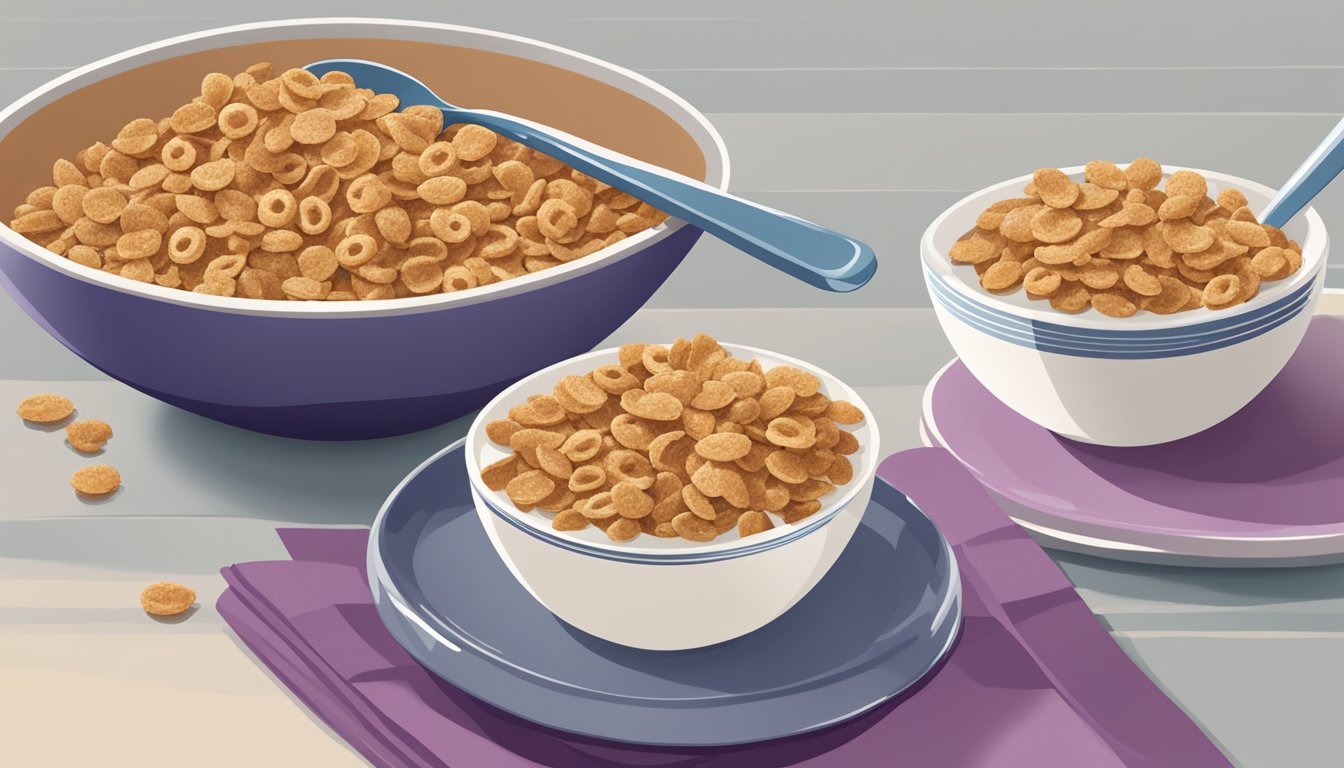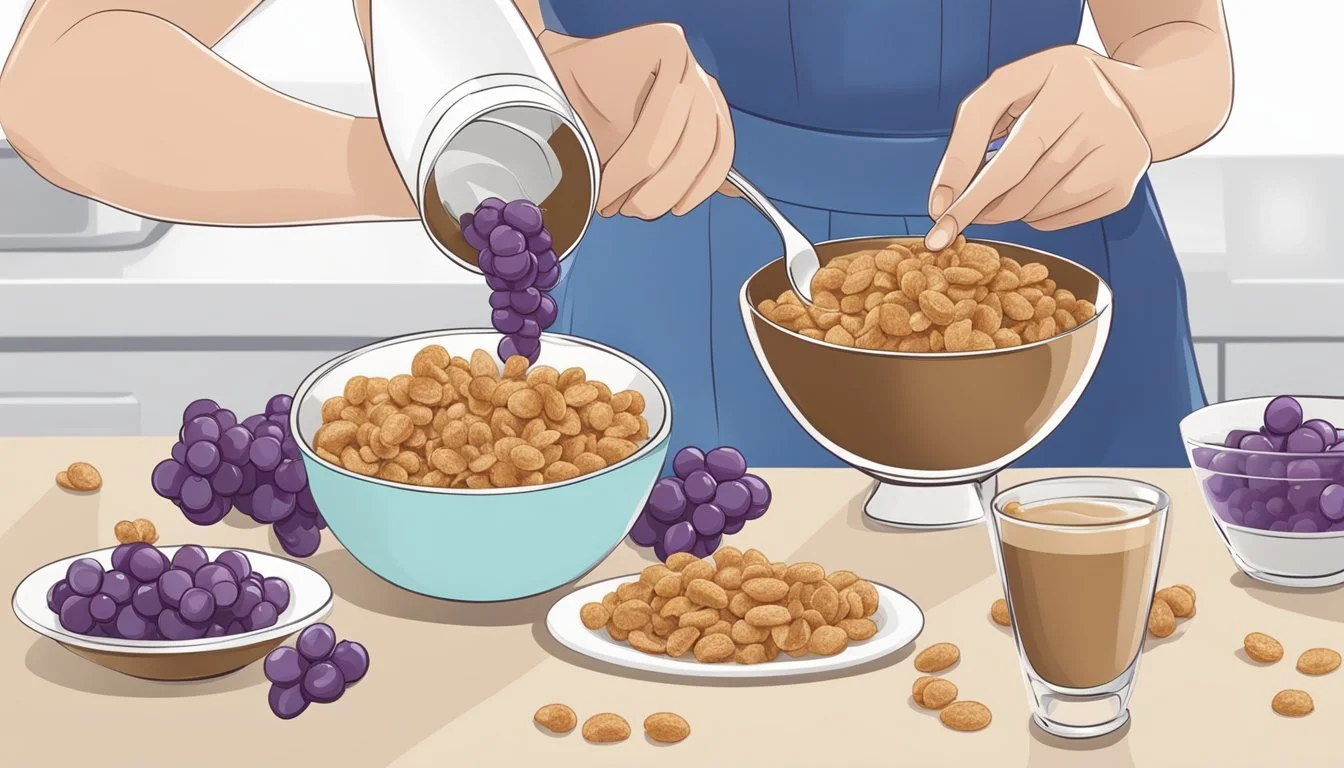Krave vs Post GrapevsNut Flakes
Comparing Breakfast Cereal Choices
This Article is Part of Our Breakfast Cereal Guide with Details on Krave Nutrition and Post GrapevsNut Flakes Nutrition
When it comes to choosing the best breakfast cereal, Krave and Post Grape-Nuts Flakes often come up in the conversation. Both offer unique nutritional profiles and cater to different tastes and preferences. For those who crave a sweet start to their day, Krave's chocolate-filled bites might be the tempting choice. However, for individuals focused on a nutrient-dense, whole grain option, Post Grape-Nuts Flakes stand out.
Krave, with its indulgent chocolate center, appeals to those with a sweet tooth while still providing some fiber and essential vitamins. On the other hand, Post Grape-Nuts Flakes pack in whole grain goodness and are low in saturated fat. Post Grape-Nuts Flakes are particularly attractive to those monitoring their heart health and aiming for a balanced diet.
Cereal ratings and health considerations are pivotal factors when making a breakfast choice. Dietitians often recommend cereals like Post Grape-Nuts Flakes for their higher fiber content and lower sugar levels, which help maintain energy levels and support digestive health throughout the day. Meanwhile, Krave may score higher on taste for those who prioritize flavor over nutritional value. This blog post delves into these aspects, helping you make an informed choice that aligns with your dietary needs and taste preferences.
Product Overview
Krave and Post Grape-Nuts Flakes are two distinct cereals that have carved out their unique places in the breakfast market. While Krave focuses on offering a chocolate-filled experience, Post Grape-Nuts Flakes emphasize whole grains and a heart-healthy profile.
History of Krave
Krave was introduced by Kellogg’s in 2012 as a cereal specifically designed for chocolate lovers. It features a distinctive dual-layer construction with a crunchy shell and a creamy chocolate center. The inspiration behind Krave was to combine the indulgence of chocolate snacks with the health benefits of breakfast cereals. In a short time, Krave gained popularity among younger demographics, mostly due to its unique flavor profile and marketing campaigns.
History of Post Grape-Nuts Flakes
Post Grape-Nuts Flakes offer a lighter alternative to the original Grape-Nuts. The original Grape-Nuts was introduced in 1897 and is known for its density and crunch. Grape-Nuts Flakes made their debut much later, aiming to provide the nutritional benefits of Grape-Nuts but in a form that is easier to eat. These flakes contain whole grains and are known for their crispy texture. They appeal to those looking for a heart-healthy cereal that is low in saturated fats.
Manufacturer of Cereal
Krave is manufactured by Kellogg’s, a global leader in the cereal market. Kellogg’s was founded in 1906 and has since then grown to produce a wide variety of breakfast options. They are known for their rigorous quality standards and innovative products.
Post Consumer Brands manufactures Grape-Nuts Flakes. This company emerged from Postum Cereal Company, founded in 1895. Today, Post Consumer Brands is one of the largest producers of ready-to-eat cereals in North America. They focus on delivering high-quality, nutritious cereals that cater to a wide audience, from children to adults.
Nutritional Comparison
For those comparing Krave and Post Grape-Nut Flakes, understanding the nutritional differences between these cereals can guide healthier choices. Key areas include calories, protein, fat, sugars, and sodium content.
Calories Per Serving
Krave provides 120 calories per 3/4 cup serving. This cereal targets younger consumers with its chocolatey flavor.
Post Grape-Nut Flakes contains approximately 110 calories per 1 cup serving, focusing on a more health-conscious crowd.
Grams of Protein Per Serving
Krave contains 2 grams of protein per serving. It's relatively low, keeping in line with its focus on taste.
Post Grape-Nut Flakes offers 4 grams of protein per serving. This higher protein content supports muscle health and satiety more effectively.
Grams of Fat Per Serving
Krave contains 3.5 grams of fat per serving, including 1 gram of saturated fat and 0 grams of trans fat. The total fat content is moderate compared to other sweet cereals.
Post Grape-Nut Flakes has 0.5 grams of fat per serving, with no saturated or trans fats. This makes it a low-fat, heart-friendly option.
Sugars
Krave has a higher sugar content with 11 grams per serving. This aligns with its dessert-like taste profile but may contribute to added sugar intake.
Post Grape-Nut Flakes has 7 grams of sugar per serving, including 7 grams of added sugars. While still sweet, it contains less total sugar compared to Krave.
Sodium
Krave contains 150 mg of sodium per serving. This amount is fairly standard but could be a consideration for those monitoring sodium intake.
Post Grape-Nut Flakes has a sodium content of 210 mg per serving. It's slightly higher than Krave, which might be a factor for individuals on a low-sodium diet.
Both cereals offer unique benefits and drawbacks based on their nutritional profiles, with Krave leaning more towards taste and Post Grape-Nut Flakes offering more heart-healthy options.
Key Ingredients Analysis
A detailed review of Krave and Post Grape-Nuts Flakes ingredients highlights their nutritional profiles, distinct benefits, and areas of concern, such as whole grain content, fiber amounts, added sugars, and mineral and vitamin presence.
Whole Grain Content
Krave features whole grain wheat as a primary ingredient, offering essential nutrients like B vitamins and antioxidants. The cereal's composition provides benefits like improved digestion and heart health.
Post Grape-Nuts Flakes are notable for their inclusion of whole grain wheat and malted barley. These components contribute to the cereal's high nutritional value. The use of malted barley in Grape-Nuts Flakes can boost enzyme activity and add a unique flavor profile.
Comparison:
Krave: Emphasizes whole grain wheat.
Grape-Nuts Flakes: Combines whole grain wheat with malted barley.
Fiber Content
Krave contains a moderate amount of dietary fiber, both soluble and insoluble, aiding in digestion and promoting sustained energy release. The inclusion of other grains and fillers could affect fiber content and overall health impact.
Post Grape-Nuts Flakes have a higher fiber content due to their use of whole grain wheat and barley. Each serving delivers a significant amount of dietary fiber, supporting digestive health and reducing the risk of various diseases.
Comparison:
Krave: Moderate fiber content.
Grape-Nuts Flakes: Higher fiber content with both soluble and insoluble fiber.
Added Sugars
Krave is known for its higher added sugar content, aiming to enhance taste and appeal. This results in a sweeter cereal, but may pose concerns for those monitoring sugar intake.
Post Grape-Nuts Flakes contain less added sugar. The natural sweetness from the malted barley and whole grains provides a balanced flavor. This lower sugar content makes it a preferred choice for individuals aiming to reduce their sugar consumption.
Comparison:
Krave: Higher in added sugars.
Grape-Nuts Flakes: Lower in added sugars.
Minerals and Vitamins
Krave contains essential minerals and vitamins such as iron, folic acid, and calcium, although the levels may vary. These nutrients are critical for maintaining overall health, including bone health and blood production.
Post Grape-Nuts Flakes are fortified with various essential vitamins and minerals, including iron, zinc, magnesium, and phosphorus. These added nutrients enhance the cereal's benefits, supporting a range of bodily functions from immune support to bone strength.
Comparison:
Krave: Provides essential vitamins and minerals but at varying levels.
Grape-Nuts Flakes: More consistently fortified with a broader range of nutrients.
Both cereals offer valuable nutritional benefits, but the choice depends on individual dietary needs and preferences.
Health Impact
When comparing Krave and Post Grape-Nuts Flakes, it is essential to understand their influence on diet and nutrition, the potential benefits and risks, and their impact on chronic diseases.
Influence on Diet and Nutrition
Krave: Krave is known for its sweet taste and appeal to younger consumers. A typical serving of this cereal may provide around 120 calories. However, it contains significant amounts of added sugars, which could be a concern for those trying to limit sugar intake.
Post Grape-Nuts Flakes: On the other hand, Post Grape-Nuts Flakes offer a higher fiber content at about 3 grams per serving, which is substantial in promoting digestive health. This cereal also contains more complex carbohydrates, which can help maintain stable blood sugar levels.
Potential Benefits and Risks
Krave: Owing to its high sugar content, regular consumption of Krave might contribute to obesity and diabetes. This cereal lacks fiber, which is crucial for maintaining a healthy digestive system.
Post Grape-Nuts Flakes: These flakes are high in fiber and complex carbohydrates, making them a healthier option. However, the sodium content in Post Grape-Nuts Flakes can be a drawback for individuals monitoring their salt intake. The cereal provides essential nutrients like iron and B vitamins but might be tough on teeth due to its hard texture.
Impact on Chronic Diseases
Krave: Due to high sugar levels, Krave may increase risks of chronic diseases such as type 2 diabetes and heart disease if consumed excessively. The low fiber content does not help in lowering cholesterol levels or maintaining heart health.
Post Grape-Nuts Flakes: The high fiber content in Post Grape-Nuts Flakes can aid in reducing cholesterol and therefore, potentially lower the risk of heart disease. This cereal's complex carbohydrates assist in preventing blood sugar spikes, thereby minimizing the risk of type 2 diabetes. However, the higher sodium content may pose a risk for hypertension if consumed in large quantities.
Serving Suggestions
To maximize the nutritional benefits and enhance the flavor of Krave and Post Grape-Nuts Flakes, consider serving them with milk or other alternatives and pairing them with complementary foods.
With Milk or Alternative
Both Krave and Post Grape-Nuts Flakes pair well with milk, providing a good source of calcium and added protein. Traditionally, 1 cup of milk contains about 8 grams of protein and 300 milligrams of calcium.
For those who prefer non-dairy options, almond, soy, or oat milk are excellent alternatives. These options are often fortified with calcium, sometimes providing similar or even higher calcium content compared to cow's milk.
Krave's chocolate flavor blends particularly well with almond milk, enhancing its sweetness. On the other hand, Post Grape-Nuts Flakes, known for their crunch and slightly nutty flavor, go well with soy milk, adding a rich, creamy texture to each bite.
Complementary Foods
Pairing Krave or Post Grape-Nuts Flakes with additional foods can create a more balanced and fulfilling meal. Fresh fruits such as bananas, strawberries, or blueberries boost vitamin intake and add natural sweetness.
Nuts and seeds, like almonds or chia seeds, add extra crunch and provide healthy fats and proteins. Yogurt, especially low-fat versions, can be mixed with these cereals, offering probiotic benefits and additional protein.
Combining Krave with yogurt and berries can create a dessert-like, nutritious breakfast while pairing Grape-Nuts Flakes with nuts and fruits ensures a hearty, fiber-rich start to the day.
Consumer Experience
Consumers often compare cereals based on taste, texture, flavor varieties, and value for money. These aspects significantly influence purchase decisions and overall satisfaction with the product.
Taste and Texture
Krave offers a chocolate-filled cereal experience, combining crunchy outer shells with a smooth chocolate center. Many consumers appreciate this contrast, describing it as indulgent yet not overly sweet. On the other hand, Post Grape-Nuts Flakes deliver a more subtle malty flavor. The flakes are lighter and less dense compared to traditional Grape-Nuts, which some find easier to munch on without compromising on the original flavor profile.
Taste Comparison:
Krave: Chocolate-rich, crunchy exterior, smooth filling
Grape-Nuts Flakes: Mild malt flavor, light and crispy texture
Flavor Varieties
Krave primarily features chocolate but also includes variations such as double chocolate and chocolate with marshmallow. These additions cater to those with a strong preference for chocolate-centric breakfasts.
Conversely, Grape-Nuts Flakes stick closely to their classic formula. While this offers consistent taste for long-time fans, it might not appeal to those seeking diverse flavors.
Available Varieties:
Krave: Original chocolate, Double chocolate, Chocolate marshmallow
Grape-Nuts Flakes: Classic malt flavor only
Value for Money
When assessing value, consumers consider both price and nutritional benefits. Krave is generally priced higher due to its premium ingredients and targeted advertising. The chocolatey allure appeals particularly to children and those looking for a treat-like breakfast.
Grape-Nuts Flakes present a nutritious option, often highlighted for their whole grains and lack of added sugars. While possibly less flamboyant, they provide substantial value through their health benefits.
Value Aspects:
Krave: Premium pricing, focused on taste and indulgence
Grape-Nuts Flakes: Cost-effective, nutritious choice with whole grains and no added sugars
More on Krave
More on Post GrapevsNut Flakes
Cinnamon Toast Crunch vs Post GrapevsNut Flakes: Which is better?
French Toast Crunch vs Post GrapevsNut Flakes: Which is better?
Honey Nut Cheerios vs Post GrapevsNut Flakes: Which is better?
Kellogg's Apple Jacks vs Post GrapevsNut Flakes: Which is better?
Kellogg's Froot Loops vs Post GrapevsNut Flakes: Which is better?
Post GrapevsNut Flakes vs Post Raisin Bran Cereal: Which is better?





